University Report: Importance of ERP Systems in Business
VerifiedAdded on 2020/03/01
|25
|5021
|90
Report
AI Summary
This report provides a comprehensive overview of the importance of Enterprise Resource Planning (ERP) systems in business. It begins by defining business processes and requirements, explaining their role in organizational success. The report then delves into the specifics of ERP systems, including their types (cloud-based, multi-tiered), requirements, and vendor selection criteria. The report outlines a step-by-step method for organizations to successfully choose and implement an ERP system, including assessing needs, forming a selection team, evaluating vendor options, and creating a project plan. Diagrams and models are included to illustrate key concepts. The report emphasizes the advantages of ERP systems in integrating business functions, improving efficiency, and facilitating informed decision-making. It highlights the shift towards cloud-based ERP systems and the benefits of multi-tiered approaches. Finally, the report provides a conclusion and references for further study.

Running head: IMPORTANCE OF ERP SYSTEMS IN BUSINESS
Importance of ERP systems in Business
Name of the Student:
Name of the University:
Author Note:
Importance of ERP systems in Business
Name of the Student:
Name of the University:
Author Note:
Paraphrase This Document
Need a fresh take? Get an instant paraphrase of this document with our AI Paraphraser
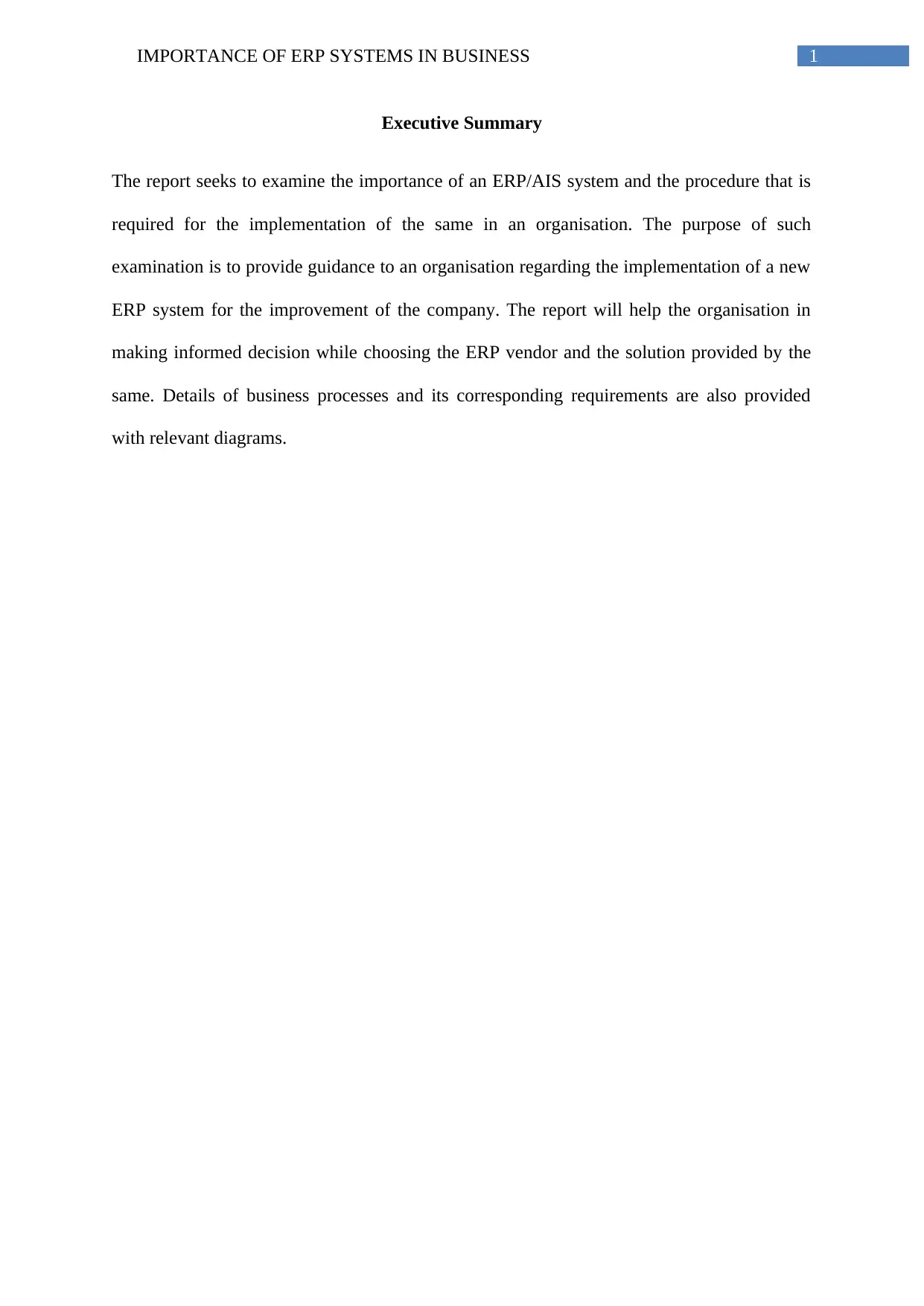
1IMPORTANCE OF ERP SYSTEMS IN BUSINESS
Executive Summary
The report seeks to examine the importance of an ERP/AIS system and the procedure that is
required for the implementation of the same in an organisation. The purpose of such
examination is to provide guidance to an organisation regarding the implementation of a new
ERP system for the improvement of the company. The report will help the organisation in
making informed decision while choosing the ERP vendor and the solution provided by the
same. Details of business processes and its corresponding requirements are also provided
with relevant diagrams.
Executive Summary
The report seeks to examine the importance of an ERP/AIS system and the procedure that is
required for the implementation of the same in an organisation. The purpose of such
examination is to provide guidance to an organisation regarding the implementation of a new
ERP system for the improvement of the company. The report will help the organisation in
making informed decision while choosing the ERP vendor and the solution provided by the
same. Details of business processes and its corresponding requirements are also provided
with relevant diagrams.
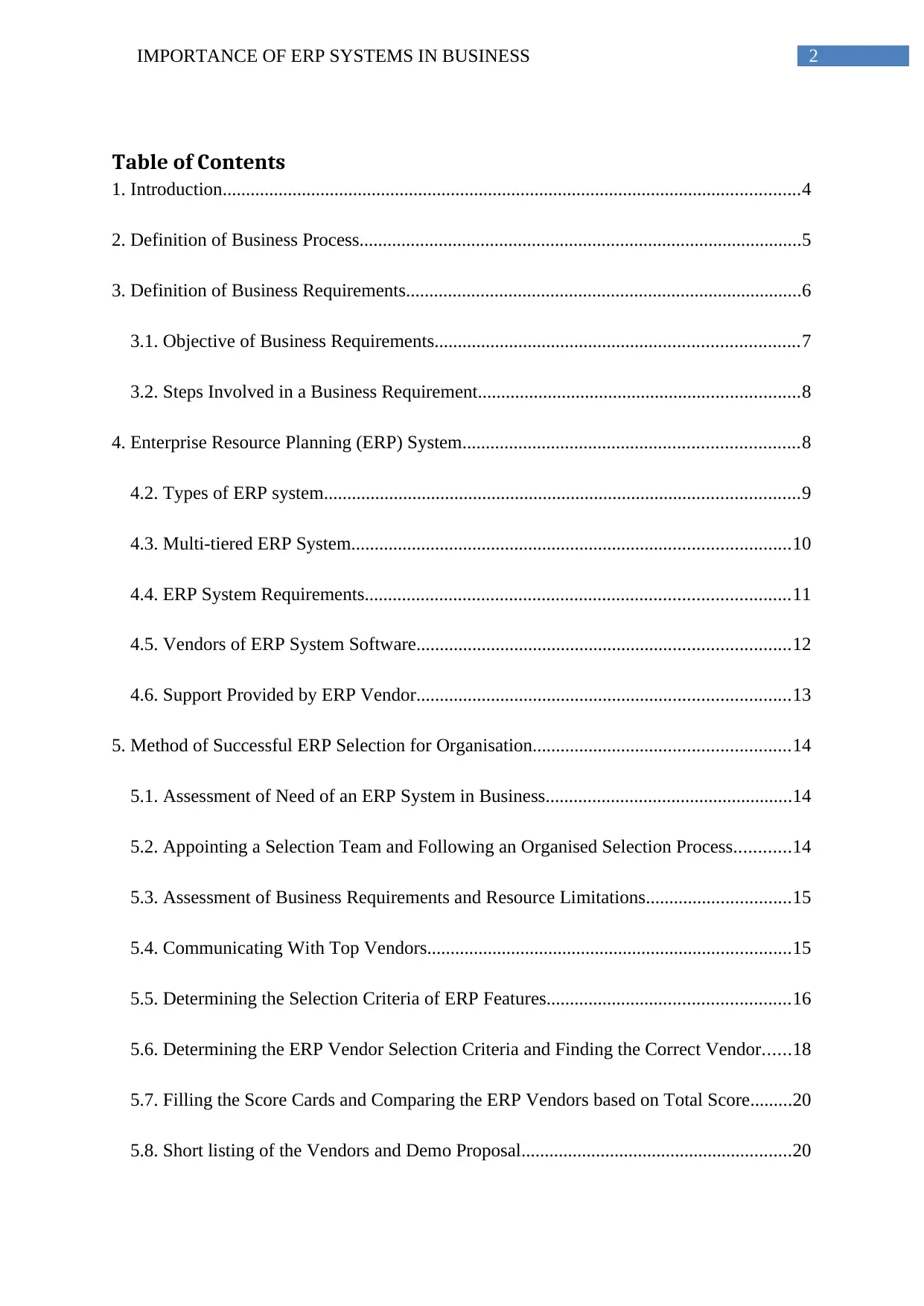
2IMPORTANCE OF ERP SYSTEMS IN BUSINESS
Table of Contents
1. Introduction............................................................................................................................4
2. Definition of Business Process...............................................................................................5
3. Definition of Business Requirements.....................................................................................6
3.1. Objective of Business Requirements..............................................................................7
3.2. Steps Involved in a Business Requirement.....................................................................8
4. Enterprise Resource Planning (ERP) System........................................................................8
4.2. Types of ERP system......................................................................................................9
4.3. Multi-tiered ERP System..............................................................................................10
4.4. ERP System Requirements...........................................................................................11
4.5. Vendors of ERP System Software................................................................................12
4.6. Support Provided by ERP Vendor................................................................................13
5. Method of Successful ERP Selection for Organisation.......................................................14
5.1. Assessment of Need of an ERP System in Business.....................................................14
5.2. Appointing a Selection Team and Following an Organised Selection Process............14
5.3. Assessment of Business Requirements and Resource Limitations...............................15
5.4. Communicating With Top Vendors..............................................................................15
5.5. Determining the Selection Criteria of ERP Features....................................................16
5.6. Determining the ERP Vendor Selection Criteria and Finding the Correct Vendor......18
5.7. Filling the Score Cards and Comparing the ERP Vendors based on Total Score.........20
5.8. Short listing of the Vendors and Demo Proposal..........................................................20
Table of Contents
1. Introduction............................................................................................................................4
2. Definition of Business Process...............................................................................................5
3. Definition of Business Requirements.....................................................................................6
3.1. Objective of Business Requirements..............................................................................7
3.2. Steps Involved in a Business Requirement.....................................................................8
4. Enterprise Resource Planning (ERP) System........................................................................8
4.2. Types of ERP system......................................................................................................9
4.3. Multi-tiered ERP System..............................................................................................10
4.4. ERP System Requirements...........................................................................................11
4.5. Vendors of ERP System Software................................................................................12
4.6. Support Provided by ERP Vendor................................................................................13
5. Method of Successful ERP Selection for Organisation.......................................................14
5.1. Assessment of Need of an ERP System in Business.....................................................14
5.2. Appointing a Selection Team and Following an Organised Selection Process............14
5.3. Assessment of Business Requirements and Resource Limitations...............................15
5.4. Communicating With Top Vendors..............................................................................15
5.5. Determining the Selection Criteria of ERP Features....................................................16
5.6. Determining the ERP Vendor Selection Criteria and Finding the Correct Vendor......18
5.7. Filling the Score Cards and Comparing the ERP Vendors based on Total Score.........20
5.8. Short listing of the Vendors and Demo Proposal..........................................................20
⊘ This is a preview!⊘
Do you want full access?
Subscribe today to unlock all pages.

Trusted by 1+ million students worldwide

3IMPORTANCE OF ERP SYSTEMS IN BUSINESS
5.9. Final Selection of the Compatible ERP Vendor and Forming the Project Plan for the
New ERP System Implementation.......................................................................................21
6. Conclusion............................................................................................................................21
7. References............................................................................................................................22
5.9. Final Selection of the Compatible ERP Vendor and Forming the Project Plan for the
New ERP System Implementation.......................................................................................21
6. Conclusion............................................................................................................................21
7. References............................................................................................................................22
Paraphrase This Document
Need a fresh take? Get an instant paraphrase of this document with our AI Paraphraser
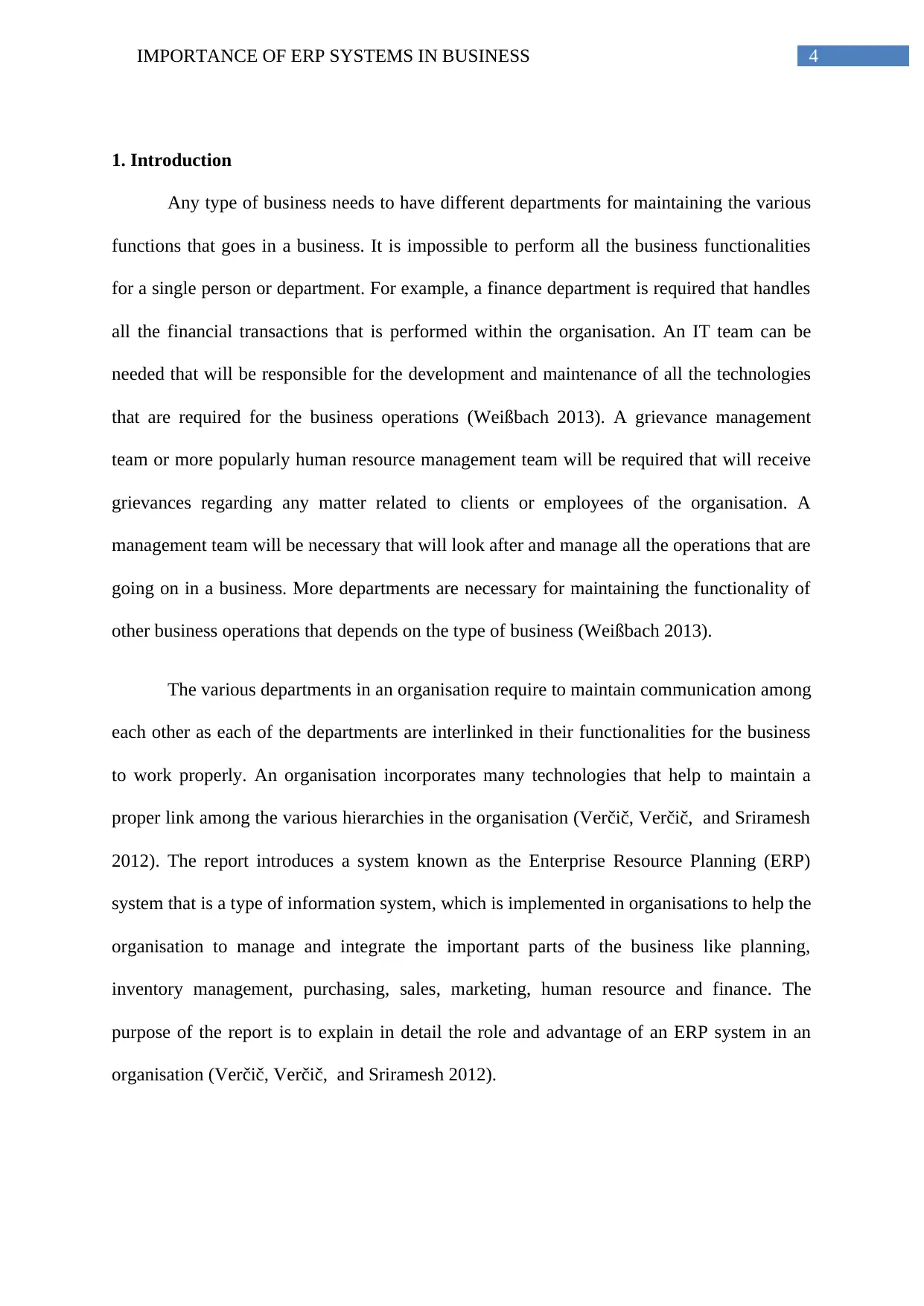
4IMPORTANCE OF ERP SYSTEMS IN BUSINESS
1. Introduction
Any type of business needs to have different departments for maintaining the various
functions that goes in a business. It is impossible to perform all the business functionalities
for a single person or department. For example, a finance department is required that handles
all the financial transactions that is performed within the organisation. An IT team can be
needed that will be responsible for the development and maintenance of all the technologies
that are required for the business operations (Weißbach 2013). A grievance management
team or more popularly human resource management team will be required that will receive
grievances regarding any matter related to clients or employees of the organisation. A
management team will be necessary that will look after and manage all the operations that are
going on in a business. More departments are necessary for maintaining the functionality of
other business operations that depends on the type of business (Weißbach 2013).
The various departments in an organisation require to maintain communication among
each other as each of the departments are interlinked in their functionalities for the business
to work properly. An organisation incorporates many technologies that help to maintain a
proper link among the various hierarchies in the organisation (Verčič, Verčič, and Sriramesh
2012). The report introduces a system known as the Enterprise Resource Planning (ERP)
system that is a type of information system, which is implemented in organisations to help the
organisation to manage and integrate the important parts of the business like planning,
inventory management, purchasing, sales, marketing, human resource and finance. The
purpose of the report is to explain in detail the role and advantage of an ERP system in an
organisation (Verčič, Verčič, and Sriramesh 2012).
1. Introduction
Any type of business needs to have different departments for maintaining the various
functions that goes in a business. It is impossible to perform all the business functionalities
for a single person or department. For example, a finance department is required that handles
all the financial transactions that is performed within the organisation. An IT team can be
needed that will be responsible for the development and maintenance of all the technologies
that are required for the business operations (Weißbach 2013). A grievance management
team or more popularly human resource management team will be required that will receive
grievances regarding any matter related to clients or employees of the organisation. A
management team will be necessary that will look after and manage all the operations that are
going on in a business. More departments are necessary for maintaining the functionality of
other business operations that depends on the type of business (Weißbach 2013).
The various departments in an organisation require to maintain communication among
each other as each of the departments are interlinked in their functionalities for the business
to work properly. An organisation incorporates many technologies that help to maintain a
proper link among the various hierarchies in the organisation (Verčič, Verčič, and Sriramesh
2012). The report introduces a system known as the Enterprise Resource Planning (ERP)
system that is a type of information system, which is implemented in organisations to help the
organisation to manage and integrate the important parts of the business like planning,
inventory management, purchasing, sales, marketing, human resource and finance. The
purpose of the report is to explain in detail the role and advantage of an ERP system in an
organisation (Verčič, Verčič, and Sriramesh 2012).
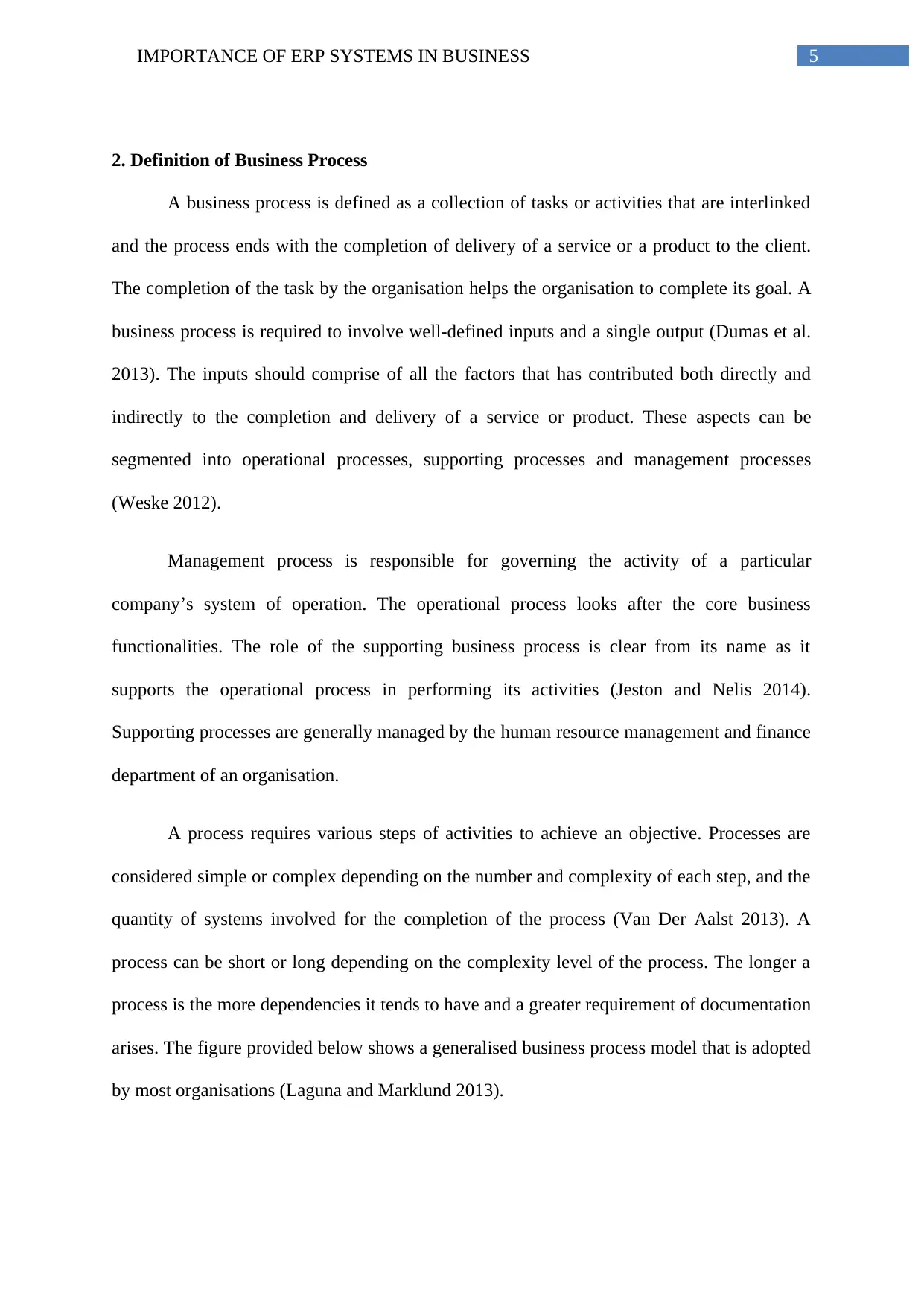
5IMPORTANCE OF ERP SYSTEMS IN BUSINESS
2. Definition of Business Process
A business process is defined as a collection of tasks or activities that are interlinked
and the process ends with the completion of delivery of a service or a product to the client.
The completion of the task by the organisation helps the organisation to complete its goal. A
business process is required to involve well-defined inputs and a single output (Dumas et al.
2013). The inputs should comprise of all the factors that has contributed both directly and
indirectly to the completion and delivery of a service or product. These aspects can be
segmented into operational processes, supporting processes and management processes
(Weske 2012).
Management process is responsible for governing the activity of a particular
company’s system of operation. The operational process looks after the core business
functionalities. The role of the supporting business process is clear from its name as it
supports the operational process in performing its activities (Jeston and Nelis 2014).
Supporting processes are generally managed by the human resource management and finance
department of an organisation.
A process requires various steps of activities to achieve an objective. Processes are
considered simple or complex depending on the number and complexity of each step, and the
quantity of systems involved for the completion of the process (Van Der Aalst 2013). A
process can be short or long depending on the complexity level of the process. The longer a
process is the more dependencies it tends to have and a greater requirement of documentation
arises. The figure provided below shows a generalised business process model that is adopted
by most organisations (Laguna and Marklund 2013).
2. Definition of Business Process
A business process is defined as a collection of tasks or activities that are interlinked
and the process ends with the completion of delivery of a service or a product to the client.
The completion of the task by the organisation helps the organisation to complete its goal. A
business process is required to involve well-defined inputs and a single output (Dumas et al.
2013). The inputs should comprise of all the factors that has contributed both directly and
indirectly to the completion and delivery of a service or product. These aspects can be
segmented into operational processes, supporting processes and management processes
(Weske 2012).
Management process is responsible for governing the activity of a particular
company’s system of operation. The operational process looks after the core business
functionalities. The role of the supporting business process is clear from its name as it
supports the operational process in performing its activities (Jeston and Nelis 2014).
Supporting processes are generally managed by the human resource management and finance
department of an organisation.
A process requires various steps of activities to achieve an objective. Processes are
considered simple or complex depending on the number and complexity of each step, and the
quantity of systems involved for the completion of the process (Van Der Aalst 2013). A
process can be short or long depending on the complexity level of the process. The longer a
process is the more dependencies it tends to have and a greater requirement of documentation
arises. The figure provided below shows a generalised business process model that is adopted
by most organisations (Laguna and Marklund 2013).
⊘ This is a preview!⊘
Do you want full access?
Subscribe today to unlock all pages.

Trusted by 1+ million students worldwide
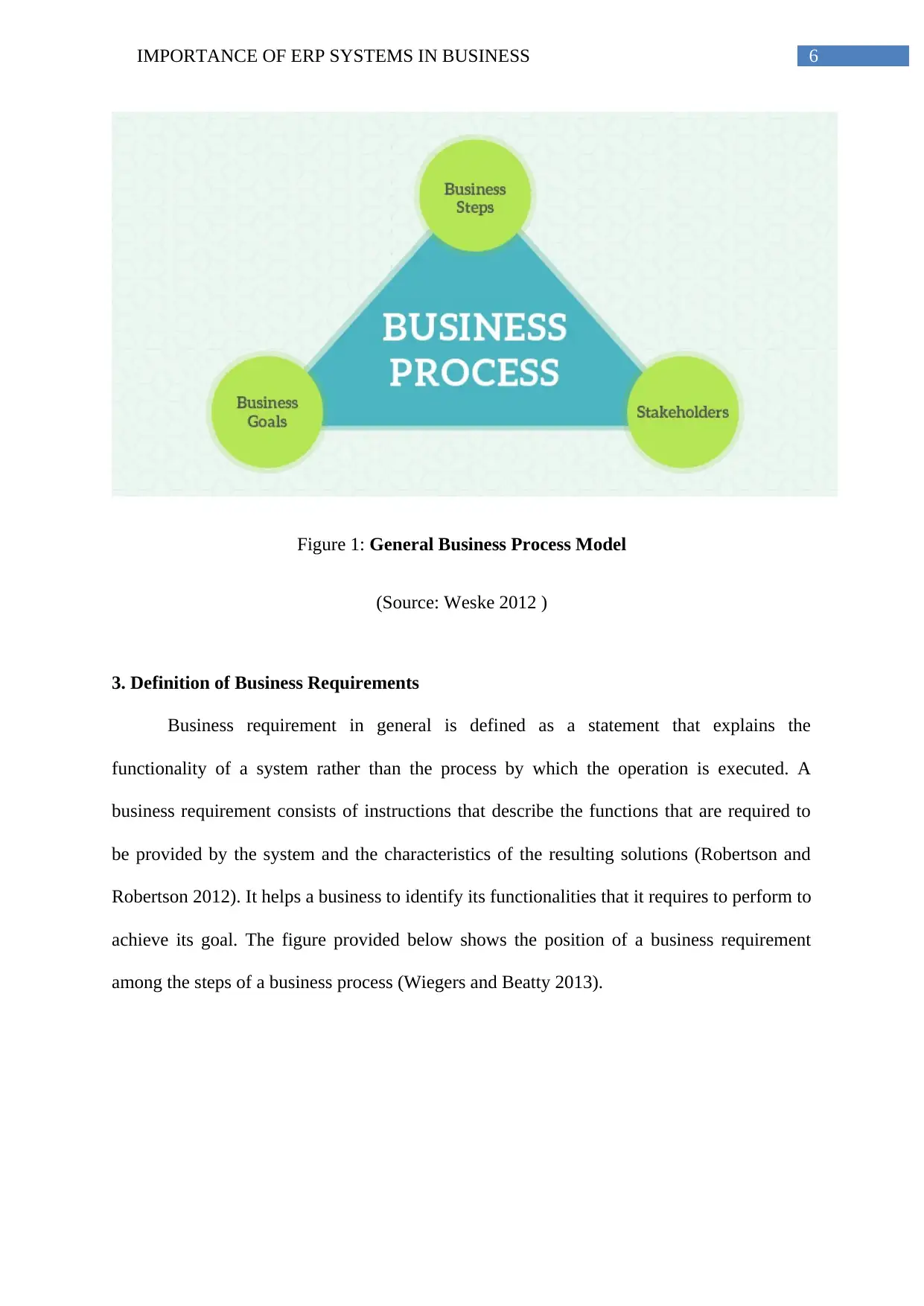
6IMPORTANCE OF ERP SYSTEMS IN BUSINESS
Figure 1: General Business Process Model
(Source: Weske 2012 )
3. Definition of Business Requirements
Business requirement in general is defined as a statement that explains the
functionality of a system rather than the process by which the operation is executed. A
business requirement consists of instructions that describe the functions that are required to
be provided by the system and the characteristics of the resulting solutions (Robertson and
Robertson 2012). It helps a business to identify its functionalities that it requires to perform to
achieve its goal. The figure provided below shows the position of a business requirement
among the steps of a business process (Wiegers and Beatty 2013).
Figure 1: General Business Process Model
(Source: Weske 2012 )
3. Definition of Business Requirements
Business requirement in general is defined as a statement that explains the
functionality of a system rather than the process by which the operation is executed. A
business requirement consists of instructions that describe the functions that are required to
be provided by the system and the characteristics of the resulting solutions (Robertson and
Robertson 2012). It helps a business to identify its functionalities that it requires to perform to
achieve its goal. The figure provided below shows the position of a business requirement
among the steps of a business process (Wiegers and Beatty 2013).
Paraphrase This Document
Need a fresh take? Get an instant paraphrase of this document with our AI Paraphraser
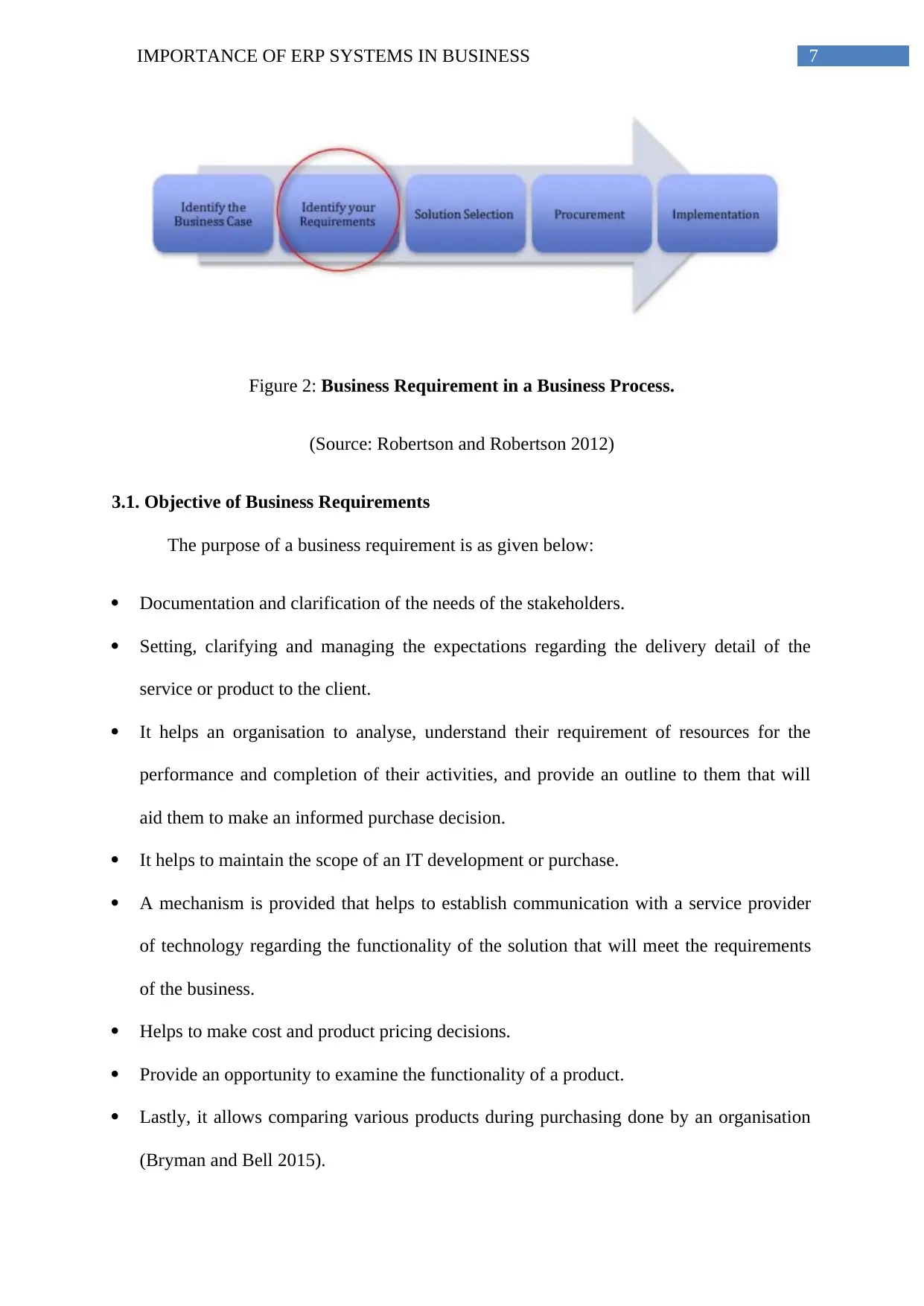
7IMPORTANCE OF ERP SYSTEMS IN BUSINESS
Figure 2: Business Requirement in a Business Process.
(Source: Robertson and Robertson 2012)
3.1. Objective of Business Requirements
The purpose of a business requirement is as given below:
Documentation and clarification of the needs of the stakeholders.
Setting, clarifying and managing the expectations regarding the delivery detail of the
service or product to the client.
It helps an organisation to analyse, understand their requirement of resources for the
performance and completion of their activities, and provide an outline to them that will
aid them to make an informed purchase decision.
It helps to maintain the scope of an IT development or purchase.
A mechanism is provided that helps to establish communication with a service provider
of technology regarding the functionality of the solution that will meet the requirements
of the business.
Helps to make cost and product pricing decisions.
Provide an opportunity to examine the functionality of a product.
Lastly, it allows comparing various products during purchasing done by an organisation
(Bryman and Bell 2015).
Figure 2: Business Requirement in a Business Process.
(Source: Robertson and Robertson 2012)
3.1. Objective of Business Requirements
The purpose of a business requirement is as given below:
Documentation and clarification of the needs of the stakeholders.
Setting, clarifying and managing the expectations regarding the delivery detail of the
service or product to the client.
It helps an organisation to analyse, understand their requirement of resources for the
performance and completion of their activities, and provide an outline to them that will
aid them to make an informed purchase decision.
It helps to maintain the scope of an IT development or purchase.
A mechanism is provided that helps to establish communication with a service provider
of technology regarding the functionality of the solution that will meet the requirements
of the business.
Helps to make cost and product pricing decisions.
Provide an opportunity to examine the functionality of a product.
Lastly, it allows comparing various products during purchasing done by an organisation
(Bryman and Bell 2015).
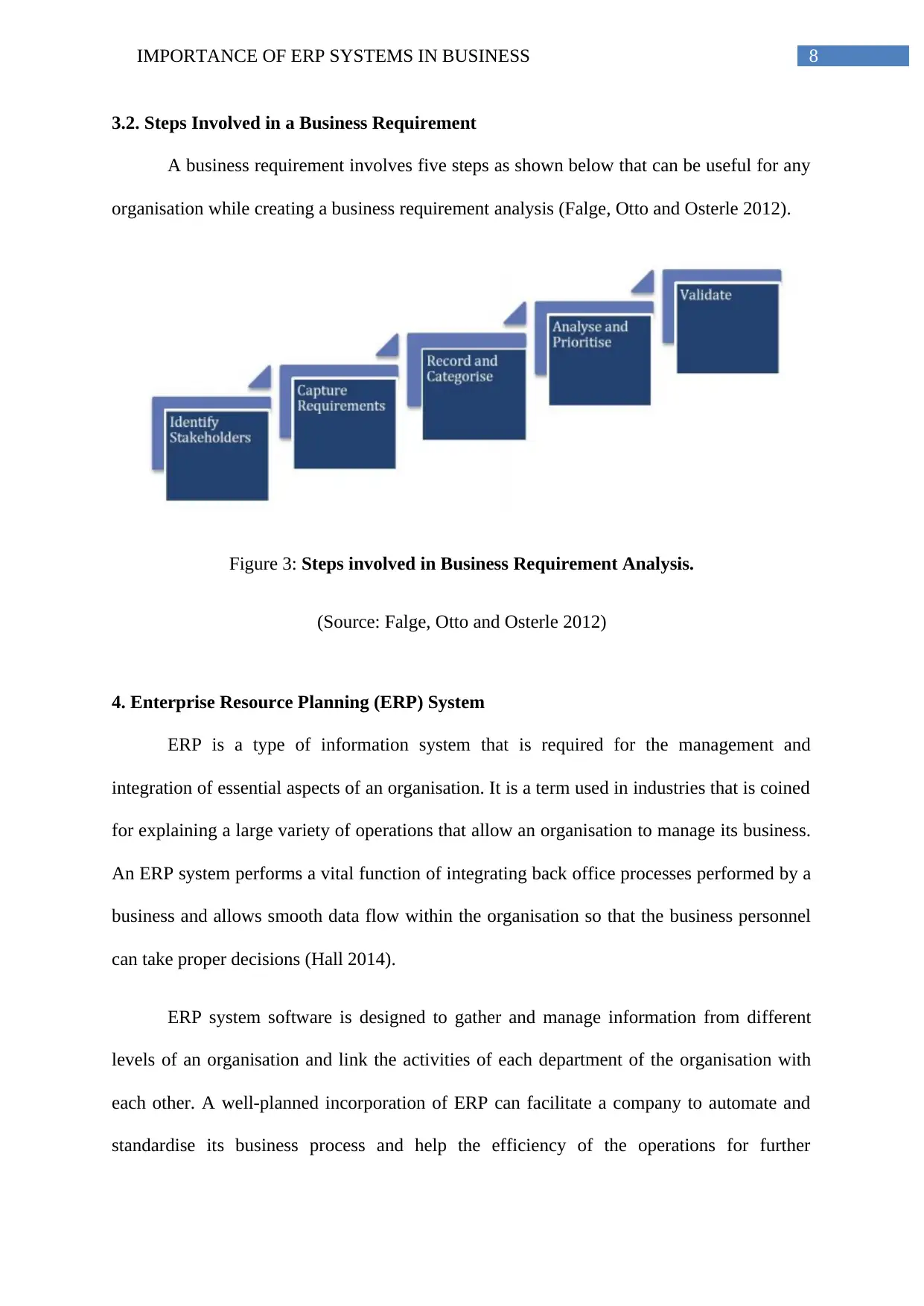
8IMPORTANCE OF ERP SYSTEMS IN BUSINESS
3.2. Steps Involved in a Business Requirement
A business requirement involves five steps as shown below that can be useful for any
organisation while creating a business requirement analysis (Falge, Otto and Osterle 2012).
Figure 3: Steps involved in Business Requirement Analysis.
(Source: Falge, Otto and Osterle 2012)
4. Enterprise Resource Planning (ERP) System
ERP is a type of information system that is required for the management and
integration of essential aspects of an organisation. It is a term used in industries that is coined
for explaining a large variety of operations that allow an organisation to manage its business.
An ERP system performs a vital function of integrating back office processes performed by a
business and allows smooth data flow within the organisation so that the business personnel
can take proper decisions (Hall 2014).
ERP system software is designed to gather and manage information from different
levels of an organisation and link the activities of each department of the organisation with
each other. A well-planned incorporation of ERP can facilitate a company to automate and
standardise its business process and help the efficiency of the operations for further
3.2. Steps Involved in a Business Requirement
A business requirement involves five steps as shown below that can be useful for any
organisation while creating a business requirement analysis (Falge, Otto and Osterle 2012).
Figure 3: Steps involved in Business Requirement Analysis.
(Source: Falge, Otto and Osterle 2012)
4. Enterprise Resource Planning (ERP) System
ERP is a type of information system that is required for the management and
integration of essential aspects of an organisation. It is a term used in industries that is coined
for explaining a large variety of operations that allow an organisation to manage its business.
An ERP system performs a vital function of integrating back office processes performed by a
business and allows smooth data flow within the organisation so that the business personnel
can take proper decisions (Hall 2014).
ERP system software is designed to gather and manage information from different
levels of an organisation and link the activities of each department of the organisation with
each other. A well-planned incorporation of ERP can facilitate a company to automate and
standardise its business process and help the efficiency of the operations for further
⊘ This is a preview!⊘
Do you want full access?
Subscribe today to unlock all pages.

Trusted by 1+ million students worldwide
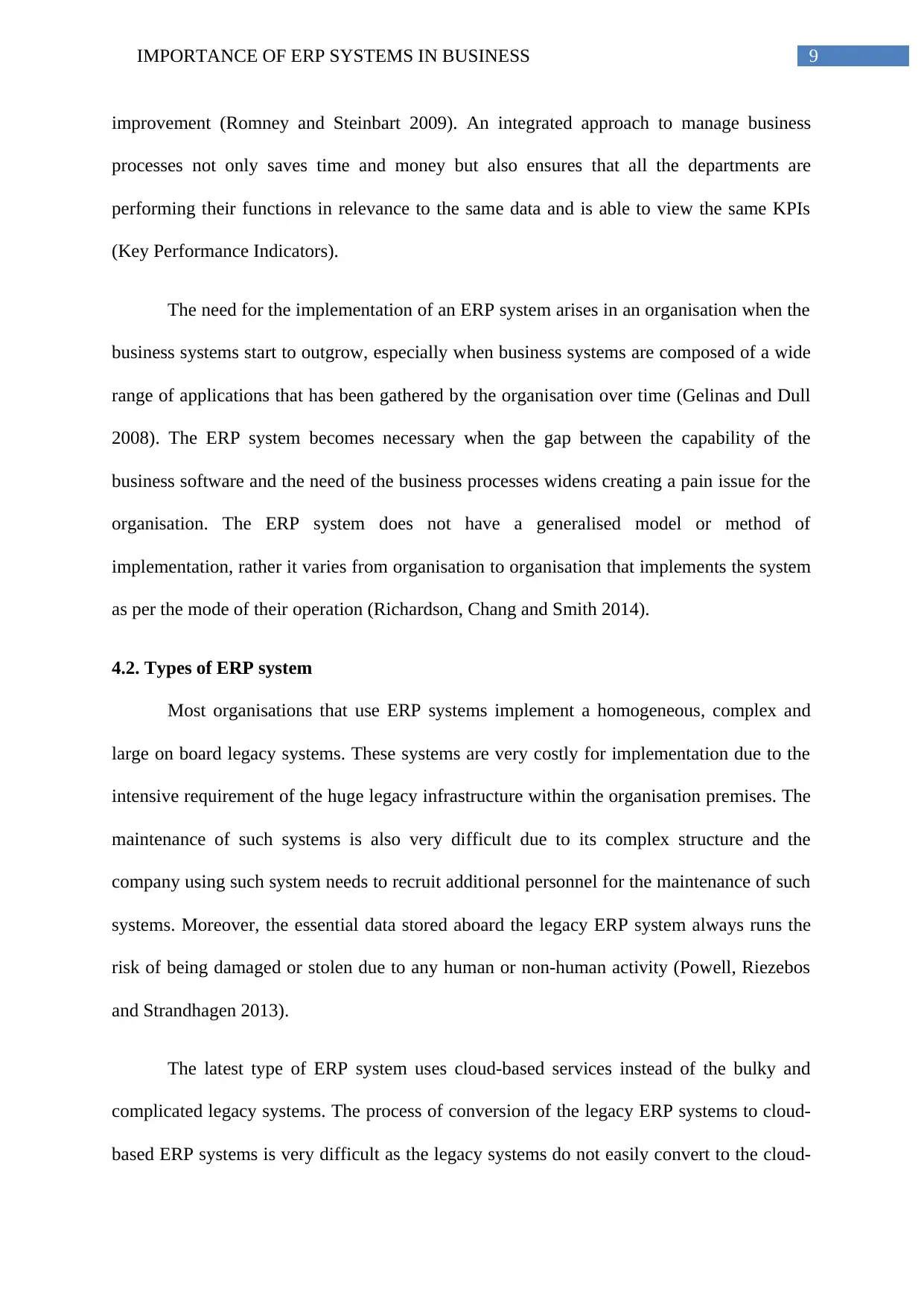
9IMPORTANCE OF ERP SYSTEMS IN BUSINESS
improvement (Romney and Steinbart 2009). An integrated approach to manage business
processes not only saves time and money but also ensures that all the departments are
performing their functions in relevance to the same data and is able to view the same KPIs
(Key Performance Indicators).
The need for the implementation of an ERP system arises in an organisation when the
business systems start to outgrow, especially when business systems are composed of a wide
range of applications that has been gathered by the organisation over time (Gelinas and Dull
2008). The ERP system becomes necessary when the gap between the capability of the
business software and the need of the business processes widens creating a pain issue for the
organisation. The ERP system does not have a generalised model or method of
implementation, rather it varies from organisation to organisation that implements the system
as per the mode of their operation (Richardson, Chang and Smith 2014).
4.2. Types of ERP system
Most organisations that use ERP systems implement a homogeneous, complex and
large on board legacy systems. These systems are very costly for implementation due to the
intensive requirement of the huge legacy infrastructure within the organisation premises. The
maintenance of such systems is also very difficult due to its complex structure and the
company using such system needs to recruit additional personnel for the maintenance of such
systems. Moreover, the essential data stored aboard the legacy ERP system always runs the
risk of being damaged or stolen due to any human or non-human activity (Powell, Riezebos
and Strandhagen 2013).
The latest type of ERP system uses cloud-based services instead of the bulky and
complicated legacy systems. The process of conversion of the legacy ERP systems to cloud-
based ERP systems is very difficult as the legacy systems do not easily convert to the cloud-
improvement (Romney and Steinbart 2009). An integrated approach to manage business
processes not only saves time and money but also ensures that all the departments are
performing their functions in relevance to the same data and is able to view the same KPIs
(Key Performance Indicators).
The need for the implementation of an ERP system arises in an organisation when the
business systems start to outgrow, especially when business systems are composed of a wide
range of applications that has been gathered by the organisation over time (Gelinas and Dull
2008). The ERP system becomes necessary when the gap between the capability of the
business software and the need of the business processes widens creating a pain issue for the
organisation. The ERP system does not have a generalised model or method of
implementation, rather it varies from organisation to organisation that implements the system
as per the mode of their operation (Richardson, Chang and Smith 2014).
4.2. Types of ERP system
Most organisations that use ERP systems implement a homogeneous, complex and
large on board legacy systems. These systems are very costly for implementation due to the
intensive requirement of the huge legacy infrastructure within the organisation premises. The
maintenance of such systems is also very difficult due to its complex structure and the
company using such system needs to recruit additional personnel for the maintenance of such
systems. Moreover, the essential data stored aboard the legacy ERP system always runs the
risk of being damaged or stolen due to any human or non-human activity (Powell, Riezebos
and Strandhagen 2013).
The latest type of ERP system uses cloud-based services instead of the bulky and
complicated legacy systems. The process of conversion of the legacy ERP systems to cloud-
based ERP systems is very difficult as the legacy systems do not easily convert to the cloud-
Paraphrase This Document
Need a fresh take? Get an instant paraphrase of this document with our AI Paraphraser
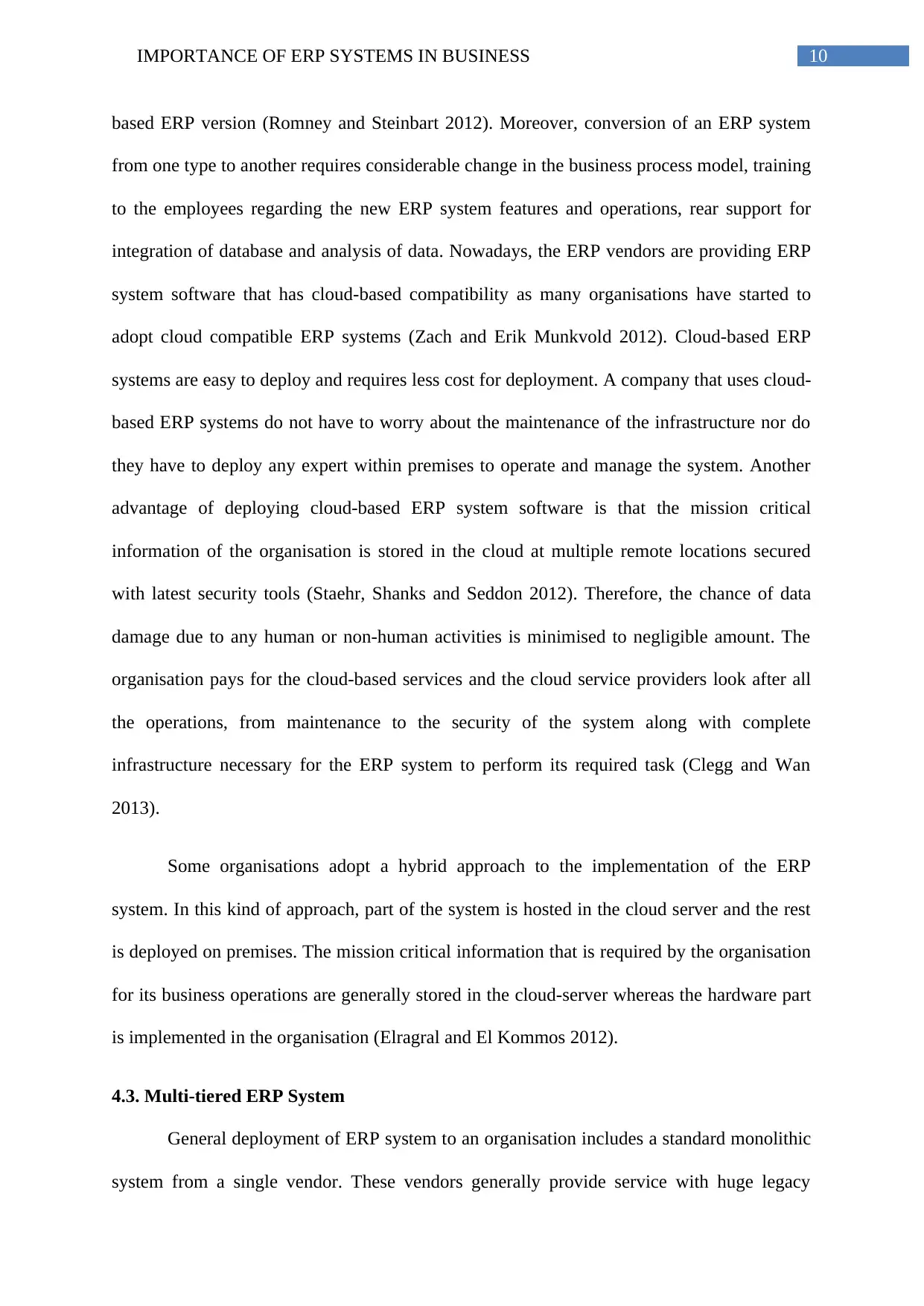
10IMPORTANCE OF ERP SYSTEMS IN BUSINESS
based ERP version (Romney and Steinbart 2012). Moreover, conversion of an ERP system
from one type to another requires considerable change in the business process model, training
to the employees regarding the new ERP system features and operations, rear support for
integration of database and analysis of data. Nowadays, the ERP vendors are providing ERP
system software that has cloud-based compatibility as many organisations have started to
adopt cloud compatible ERP systems (Zach and Erik Munkvold 2012). Cloud-based ERP
systems are easy to deploy and requires less cost for deployment. A company that uses cloud-
based ERP systems do not have to worry about the maintenance of the infrastructure nor do
they have to deploy any expert within premises to operate and manage the system. Another
advantage of deploying cloud-based ERP system software is that the mission critical
information of the organisation is stored in the cloud at multiple remote locations secured
with latest security tools (Staehr, Shanks and Seddon 2012). Therefore, the chance of data
damage due to any human or non-human activities is minimised to negligible amount. The
organisation pays for the cloud-based services and the cloud service providers look after all
the operations, from maintenance to the security of the system along with complete
infrastructure necessary for the ERP system to perform its required task (Clegg and Wan
2013).
Some organisations adopt a hybrid approach to the implementation of the ERP
system. In this kind of approach, part of the system is hosted in the cloud server and the rest
is deployed on premises. The mission critical information that is required by the organisation
for its business operations are generally stored in the cloud-server whereas the hardware part
is implemented in the organisation (Elragral and El Kommos 2012).
4.3. Multi-tiered ERP System
General deployment of ERP system to an organisation includes a standard monolithic
system from a single vendor. These vendors generally provide service with huge legacy
based ERP version (Romney and Steinbart 2012). Moreover, conversion of an ERP system
from one type to another requires considerable change in the business process model, training
to the employees regarding the new ERP system features and operations, rear support for
integration of database and analysis of data. Nowadays, the ERP vendors are providing ERP
system software that has cloud-based compatibility as many organisations have started to
adopt cloud compatible ERP systems (Zach and Erik Munkvold 2012). Cloud-based ERP
systems are easy to deploy and requires less cost for deployment. A company that uses cloud-
based ERP systems do not have to worry about the maintenance of the infrastructure nor do
they have to deploy any expert within premises to operate and manage the system. Another
advantage of deploying cloud-based ERP system software is that the mission critical
information of the organisation is stored in the cloud at multiple remote locations secured
with latest security tools (Staehr, Shanks and Seddon 2012). Therefore, the chance of data
damage due to any human or non-human activities is minimised to negligible amount. The
organisation pays for the cloud-based services and the cloud service providers look after all
the operations, from maintenance to the security of the system along with complete
infrastructure necessary for the ERP system to perform its required task (Clegg and Wan
2013).
Some organisations adopt a hybrid approach to the implementation of the ERP
system. In this kind of approach, part of the system is hosted in the cloud server and the rest
is deployed on premises. The mission critical information that is required by the organisation
for its business operations are generally stored in the cloud-server whereas the hardware part
is implemented in the organisation (Elragral and El Kommos 2012).
4.3. Multi-tiered ERP System
General deployment of ERP system to an organisation includes a standard monolithic
system from a single vendor. These vendors generally provide service with huge legacy
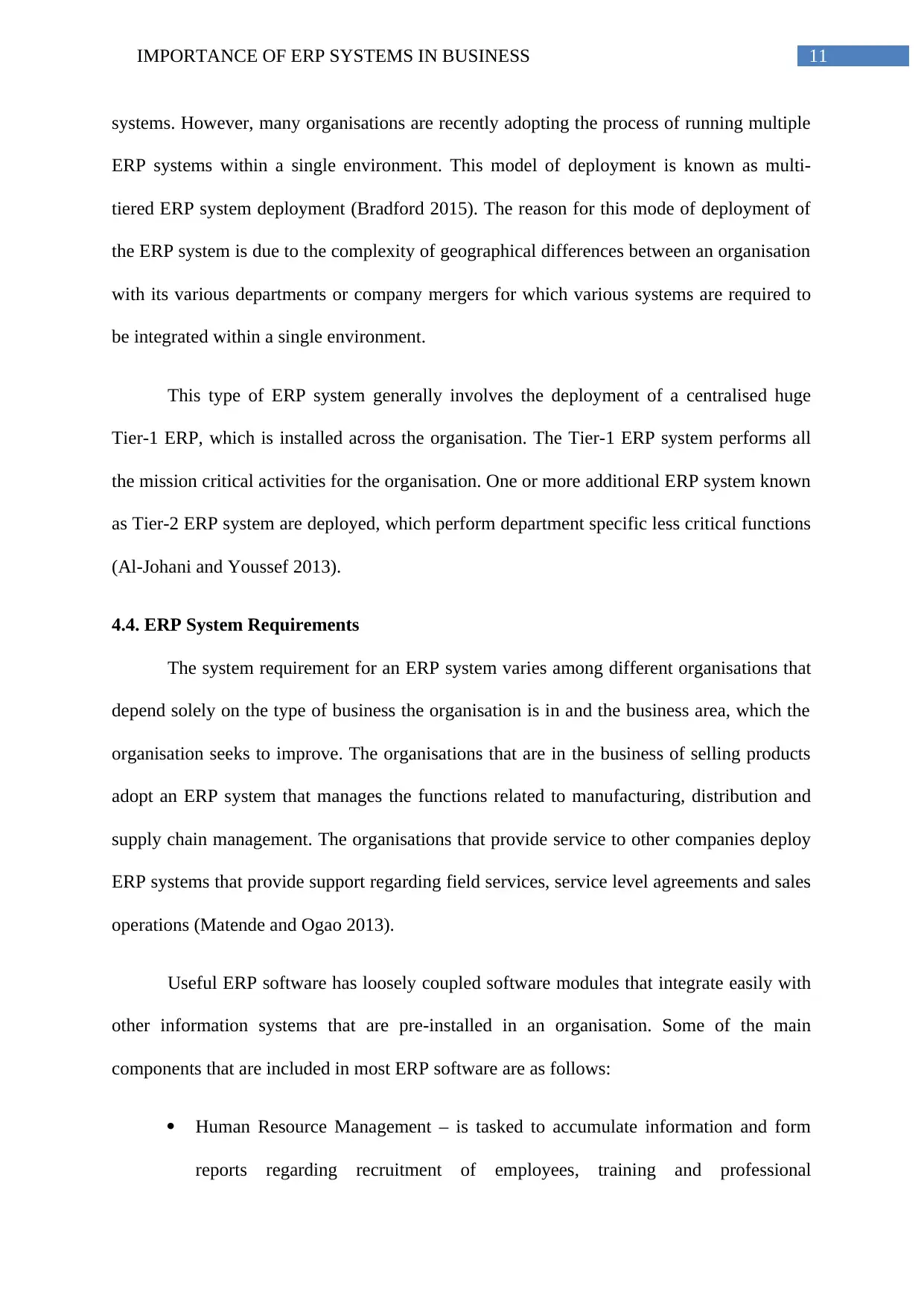
11IMPORTANCE OF ERP SYSTEMS IN BUSINESS
systems. However, many organisations are recently adopting the process of running multiple
ERP systems within a single environment. This model of deployment is known as multi-
tiered ERP system deployment (Bradford 2015). The reason for this mode of deployment of
the ERP system is due to the complexity of geographical differences between an organisation
with its various departments or company mergers for which various systems are required to
be integrated within a single environment.
This type of ERP system generally involves the deployment of a centralised huge
Tier-1 ERP, which is installed across the organisation. The Tier-1 ERP system performs all
the mission critical activities for the organisation. One or more additional ERP system known
as Tier-2 ERP system are deployed, which perform department specific less critical functions
(Al-Johani and Youssef 2013).
4.4. ERP System Requirements
The system requirement for an ERP system varies among different organisations that
depend solely on the type of business the organisation is in and the business area, which the
organisation seeks to improve. The organisations that are in the business of selling products
adopt an ERP system that manages the functions related to manufacturing, distribution and
supply chain management. The organisations that provide service to other companies deploy
ERP systems that provide support regarding field services, service level agreements and sales
operations (Matende and Ogao 2013).
Useful ERP software has loosely coupled software modules that integrate easily with
other information systems that are pre-installed in an organisation. Some of the main
components that are included in most ERP software are as follows:
Human Resource Management – is tasked to accumulate information and form
reports regarding recruitment of employees, training and professional
systems. However, many organisations are recently adopting the process of running multiple
ERP systems within a single environment. This model of deployment is known as multi-
tiered ERP system deployment (Bradford 2015). The reason for this mode of deployment of
the ERP system is due to the complexity of geographical differences between an organisation
with its various departments or company mergers for which various systems are required to
be integrated within a single environment.
This type of ERP system generally involves the deployment of a centralised huge
Tier-1 ERP, which is installed across the organisation. The Tier-1 ERP system performs all
the mission critical activities for the organisation. One or more additional ERP system known
as Tier-2 ERP system are deployed, which perform department specific less critical functions
(Al-Johani and Youssef 2013).
4.4. ERP System Requirements
The system requirement for an ERP system varies among different organisations that
depend solely on the type of business the organisation is in and the business area, which the
organisation seeks to improve. The organisations that are in the business of selling products
adopt an ERP system that manages the functions related to manufacturing, distribution and
supply chain management. The organisations that provide service to other companies deploy
ERP systems that provide support regarding field services, service level agreements and sales
operations (Matende and Ogao 2013).
Useful ERP software has loosely coupled software modules that integrate easily with
other information systems that are pre-installed in an organisation. Some of the main
components that are included in most ERP software are as follows:
Human Resource Management – is tasked to accumulate information and form
reports regarding recruitment of employees, training and professional
⊘ This is a preview!⊘
Do you want full access?
Subscribe today to unlock all pages.

Trusted by 1+ million students worldwide
1 out of 25
Related Documents
Your All-in-One AI-Powered Toolkit for Academic Success.
+13062052269
info@desklib.com
Available 24*7 on WhatsApp / Email
![[object Object]](/_next/static/media/star-bottom.7253800d.svg)
Unlock your academic potential
Copyright © 2020–2025 A2Z Services. All Rights Reserved. Developed and managed by ZUCOL.





